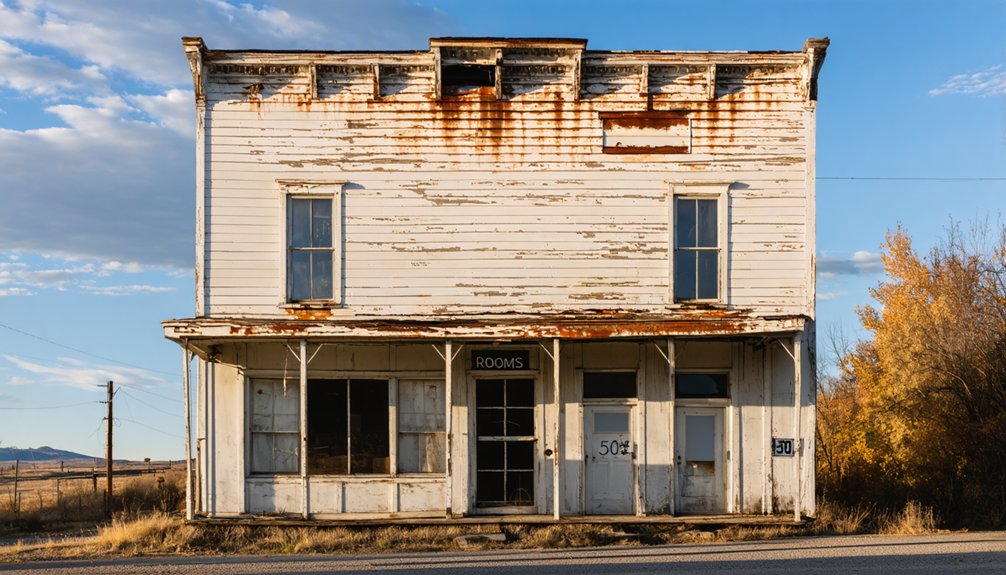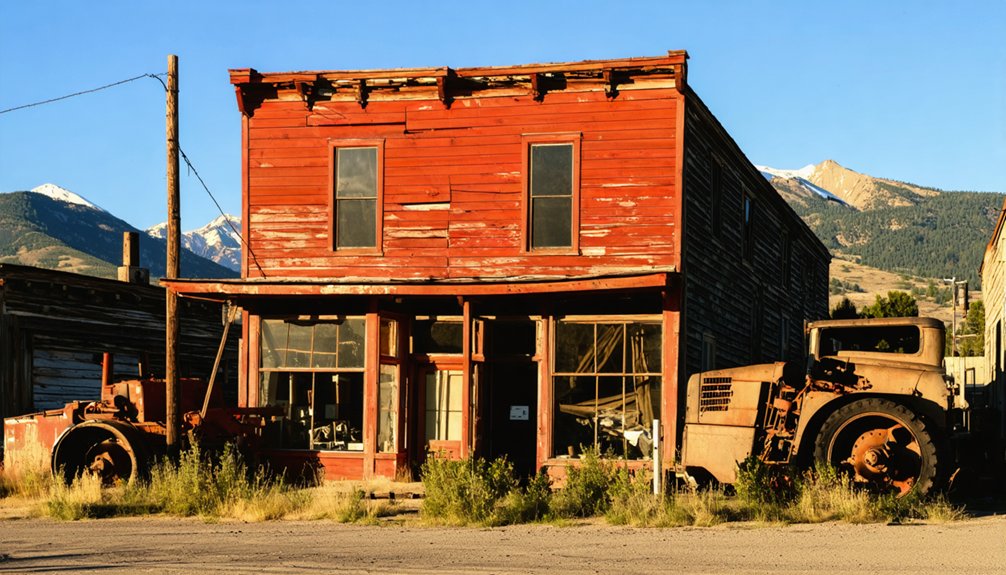You’ll find the ghost town of Dewey nestled in the rugged Owyhee Mountains of Idaho, where gold fever transformed a Native American region into a bustling mining camp in the 1860s. Colonel Dewey purchased the town in 1896, building a grand three-story hotel and modernizing operations with electric mills and advanced mining technology. After the hotel burned down and mining declined in the early 1900s, Dewey’s abandoned ruins now tell a fascinating tale of boom-and-bust ambition.
Key Takeaways
- Dewey is an abandoned mining town in Idaho established by Colonel Dewey in 1896, featuring a luxurious hotel and advanced mining operations.
- The town’s centerpiece, Hotel Dewey, burned down after 1900, marking the beginning of the settlement’s decline into a ghost town.
- Dewey’s infrastructure included a cement power plant, city water lines, and a post office established in 1897.
- Economic failure stemmed from poor ore quality and mining challenges, including the Dewey Mine tunnel collapse in 1906.
- Today, visitors can explore ruins including the cement power plant building and mine dumps during summer months.
The Birth of Boonville: First Settlement and Gold Discovery
Before the establishment of Boonville in the early 1860s, the area’s sole inhabitants were Native American tribes, primarily ancestors of the Shoshone-Bannock peoples who relied on the region’s abundant natural resources.
You’d have found them hunting bison and elk, fishing local streams, and gathering camas roots throughout their seasonal migrations.
Everything changed when gold fever struck Idaho in the early 1860s. Local legends tell of prospectors who followed the paths first blazed by mountain men like John Colter and Captain Bonneville.
As news of gold discoveries spread, Boonville emerged as a bustling mining camp. You would’ve witnessed a rapid transformation as prospectors erected log cabins and tents, while merchants rushed to establish essential businesses.
Despite frequent conflicts with Shoshone bands protecting their ancestral lands, the area’s population swelled to thousands by winter 1862-63. Mining in the region proved lucrative, with some prospectors earning up to three hundred dollars daily from their claims. The area’s gold rush would eventually yield an estimated fifty million dollars in precious metals.
Colonel Dewey’s Vision: A Town Transformed
When Colonel Dewey purchased Boonville in 1896, he’d envisioned transforming the simple settlement into a modern mining hub complete with state-of-the-art facilities.
You’ll find his ambitious plans reflected in the construction of a three-story hotel and the development of advanced milling operations that supported the Black Jack Mine. The Hotel Dewey’s architecture became a standout feature of the transformed town.
His infrastructure investments extended beyond the town’s borders with the creation of the Boise, Nampa & Owyhee Railroad and a pioneering steel bridge across the Snake River, connecting Dewey to essential transportation networks.
Tragically, the town’s prosperity was cut short when the hotel burned down after the turn of the century, leading to Dewey’s eventual decline into a ghost town.
Modernizing A Mining Town
After establishing his mining empire in the late 19th century, Colonel William H. Dewey transformed Booneville into a modernized mining hub that would reflect his ambitious vision for Idaho’s cultural heritage. In 1896, he purchased the townsite and renamed it Dewey, investing heavily in infrastructure that would serve the community’s growing needs.
You’ll find his innovative approach reflected in the way he developed the Black Jack and Trade Dollar mines with advanced technology, making it possible to process lower-grade ore profitably. His visionary spirit led to the construction of the Boise, Nampa & Owyhee railroad line.
His community revival efforts extended beyond mining operations, as he constructed hotels and pursued railroad development projects. The addition of the twenty-stamp mill by Florida M. & M. Co. represented one of the largest such facilities in the Western United States.
Despite facing significant financial challenges, including legal expenses and market fluctuations, Dewey’s determination to modernize the town created lasting impacts on Owyhee County’s economic landscape.
Infrastructure That Changed Dewey
Under Colonel William H. Dewey’s visionary leadership, you’ll discover how infrastructure innovation transformed a humble mining settlement into a thriving town. He erected one of Idaho’s finest twenty-stamp mills, constructed the prestigious Dewey Hotel, and built numerous residences that attracted permanent settlers.
His most ambitious project was founding the Boise, Nampa & Owyhee Railway, complete with a steel bridge across Snake River at Guffey. This railway network, built to exacting standards, connected Dewey to essential regional markets. The extension of rail service to Payette Lakes in 1902 further enhanced the region’s transportation capabilities. The project required significant funding, which Dewey secured by selling his Trade Dollar stock.
The community’s resilience grew through his strategic investments: a new post office, modern commercial buildings, and enhanced mining operations at Trade Dollar and Black Jack mines. These improvements created an economic ecosystem that positioned Dewey as a significant player in southern Idaho’s development, attracting out-of-state investment and sustained growth.
Mining Technologies and Economic Growth
You’ll find Dewey’s mining evolution tracked the broader shift from simple placer techniques to capital-intensive hard rock operations, as miners progressed from basic tools like rockers and sluices to advanced stamp mills and electric cyanide plants.
The introduction of William H. Dewey’s 20-stamp mill and later a 100-ton processing facility marked significant technological leaps that increased ore throughput and processing efficiency. The three-story hotel was constructed during this period of technological advancement and economic growth.
These infrastructure investments, including water lines and power plants, helped extend the town’s productive mining period while creating lasting improvements to the remote region. Similar to Silver City’s mines, the implementation of Swan Falls electricity revolutionized local mining capabilities and processing methods.
Mining Methods Evolution
Mining methods around Dewey evolved dramatically from simple placer operations to complex underground enterprises between the 1860s and early 1900s.
When placer mining declined by 1865, you’d have seen a shift toward sophisticated quartz mining techniques that demanded extensive capital investment and technological advancements.
As surface deposits depleted, mining operations adapted to geological challenges posed by the Mt. Idaho fault structures.
You’ll find that underground operations incorporated adits for accessing ore bodies, while new milling techniques like 20-stamp mills and cyanide processing improved gold recovery from complex ores.
Geological mapping enhanced mining safety and efficiency.
The change from basic sluicing to advanced extraction methods, supported by electric hoists and improved ventilation systems, guaranteed the district’s economic sustainability beyond surface gold exhaustion.
Capital Investment Impact
The rapid evolution of mining techniques in Dewey demanded substantial capital investment, which Colonel W.H. Dewey initiated after purchasing the property in 1896. His strategic capital investments transformed the decaying settlement into a thriving mining camp, complete with a 20-stamp mill, Hotel Dewey, power plant, and city water line.
You’ll find that this economic transformation was largely driven by technological advancements, particularly the introduction of electric cyanide process plants that improved metal recovery rates.
The installation of dams and electric plants helped power the milling equipment more efficiently, reducing operational costs while increasing output. These improvements attracted workers and supporting businesses to the area, creating a ripple effect of prosperity throughout Owyhee County.
The modernized infrastructure served as a model for other mining operations in the region.
Life in the Owyhee Mountains: Geography and Climate
Located in both Owyhee County, Idaho, and Malheur County, Oregon, the rugged Owyhee Mountains present a dramatic landscape of volcanic craters, deep canyons, and diverse geological formations.
The Owyhee geography features elevations ranging from 2,000 to over 8,000 feet, with vertical canyon drops exceeding 1,000 feet carved by the Owyhee River. You’ll encounter a land shaped by volcanic forces, with basalt plateaus and mineral-rich deposits scattered throughout.
The Mountain climate delivers stark contrasts throughout the year. While you’ll face hot, arid conditions in the desert regions during summer, heavy winter snows can close the Silver City Stage Road.
The terrain supports steppe-like vegetation and juniper at lower elevations, adapting to the region’s temperature extremes typical of the Great Basin.
The Golden Era: Peak Years and Prosperity

Within this challenging mountain terrain emerged a thriving community when Colonel William H. Dewey transformed the former Booneville site into a sophisticated mining community in 1896.
You’d have witnessed remarkable prosperity indicators throughout the town: a massive 20-stamp mill processing gold and silver quartz, the prestigious Hotel Dewey hosting political dignitaries, and modern amenities like a cement powerplant and city water lines.
The town’s success centered on Florida Mountain’s rich deposits, with Dewey’s mining company leveraging advanced technology to maximize output.
You’d have found a complete array of services – from steam laundries to livery stables – supporting the bustling population.
The establishment of a post office in 1897 cemented Dewey’s status as a prominent regional hub where frontier spirit met industrial progress.
Decline and Abandonment: The End of an Era
Despite its earlier prosperity, Dewey’s fate began to unravel in the early 20th century as a perfect storm of challenges struck the once-thriving mining town.
You’d have witnessed economic instability take hold as mining operations struggled with poor ore quality and collapsed tunnels at the Dewey Mine in 1906.
The community’s resilience was tested by devastating setbacks, including the Hotel Dewey fire and a massive mudslide in 1909 that dammed Monumental Creek.
The town’s dependence on mining proved fatal when operations couldn’t adapt to new technologies, and the failure to diversify spelled doom.
Historical Legacy and Ghost Town Tourism

Today, Dewey’s abandoned ruins stand as silent witnesses to Idaho’s rich mining heritage, telling a compelling story that began in 1863 when the Jordan Party first discovered gold in the area.
When you visit this historic site, you’ll find remnants of its prosperous past, including a cement powerplant building and mine dumps that highlight its historical significance in Owyhee County’s mining boom.
Unlike the more commercialized Silver City nearby, Dewey maintains a raw, untouched authenticity that ghost town preservation efforts have largely left undisturbed.
Dewey stands frozen in time, its weathered ruins offering visitors an authentic glimpse into Idaho’s untamed mining past.
You can explore the former site of the grand 60-room Hotel Dewey and imagine the bustling mining community that once thrived here.
During summer months, you’ll join other history enthusiasts hiking through these ruins, discovering firsthand how this settlement shaped Idaho’s mining era.
Frequently Asked Questions
What Happened to Colonel Dewey After the Town’s Decline?
Like a ship changing course, you’ll find Colonel Dewey’s legacy shifted from mining to railroads and hotels. He built the Idaho Northern Railway, constructed Dewey Palace Hotel, but died in 1903 shortly after.
Are There Any Remaining Descendants of Original Dewey Residents Today?
You’ll find it’s challenging to confirm descendant stories of original residents today, as family histories weren’t well documented, and most inhabitants dispersed after the town’s decline in the early 1900s.
What Artifacts Have Been Found in Archaeological Excavations Around Dewey?
You’ll discover mining tools, broken glass bottles from the 1860s-1920s, ceramics from boarding houses, and remnants of mining structures. Excavations have also revealed domestic items and industrial equipment from assay offices.
How Did Native American Tribes Interact With Early Dewey Settlers?
You’ll find that Native Americans maintained limited trade relationships with Dewey settlers, though cultural exchanges were minimal. Conflicts arose over resources, while some tribes established occasional trading partnerships despite language barriers.
What Were the Most Common Causes of Death in Dewey?
Ever wonder what claimed lives in frontier mining towns? You’d likely face death from mining accidents, including cave-ins and equipment failures, while disease outbreaks and harsh living conditions took their toll without proper medical care.
References
- https://westernmininghistory.com/towns/idaho/dewey/
- http://www.ghosttowngallery.com/htme/dewey.htm
- https://www.ghosttowns.com/states/id/dewey.html
- http://owyhee.idgenweb.org/history/hst-dewey.html
- https://kids.kiddle.co/Dewey
- https://www.youtube.com/watch?v=ZhdjAf6R9fU
- https://territory-mag.com/articles/a-ghost-town-no-more/
- https://accessgenealogy.com/delaware/early-settlement-of-idaho.htm
- https://history.idaho.gov/wp-content/uploads/0179.pdf
- https://en.wikipedia.org/wiki/Bonneville_County



